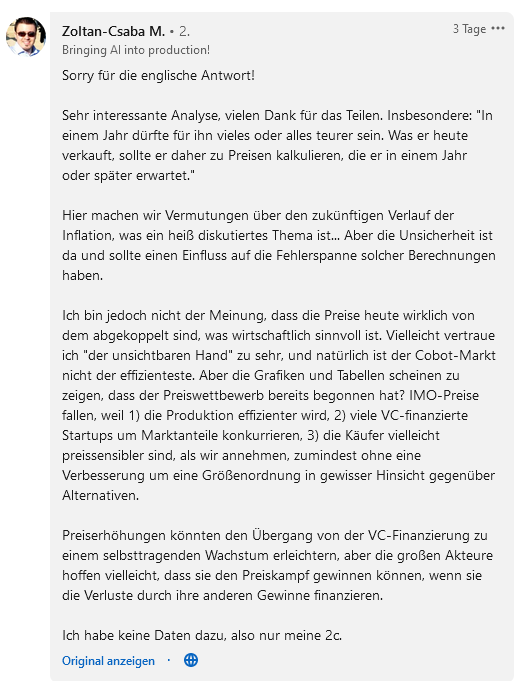Robotik-Firmen, erhöht die Preise! (Teil 2)
Vor zwei Wochen erschien hier ein Meinungsbeitrag mit gleichlautendem Titel. Die Resonanz war so groß, dass ich mich für einen zwieten Teil entschloss. Einerseits gab es Zustimmung („Franka hat damals die Preise zerstört“), andererseits aber auch Erwiderung. Nachfolgend die eines Lesers, der seine private Meinung äußert. Sein Post auf LinkedIn war auf Englisch, ich habe ihn automatisch übersetzen lassen.
Besuchen Sie den Deutschen Robotikverband für mehr Informationen.

Sind die Preise abgekoppelt?
Die Frage läßt sich aus unterschiedlichen Perspektiven beantworten. Gemessen an der unveränderten und eher zunehmenden Lieferproblematik sind die Preise zu niedirg. Die Lieferzeiten bei Universal Robots nehmen zu. Von den Autoherstellern wie BMW oder Mercedes ist bekannt, dass sie die vor den Lieferengpässen gängigen zweistelligen Rabatte nicht mehr geben. Bei den Cobots dürfte sich der Netto-Preis hingegen nicht bedeutend verändert haben. Im Gegenteil: Universal Robots hat die Traglast des UR 10e ohne Preiserhöhung von 10 kg auf 12,5 kg erhöht. Damit kam es faktisch zu einer Preissenkung.
Aus Kundensicht nimmt das Interesse an Cobots stetig zu. Dies letztlich aus zwei Gründen: Sie werden vertrauter und zugleich vergrößert sich der Personalmanagel. Wer vertraut, ist bereit mehr zu zahlen. Selbst bei einer deutlichen Preiserhöhung wäre für das Gros der Investitionen die Amortisation noch sehr gut.
Niedrigere Preise durch Venture Capital-Kaptal?
Die Grunddenke der VC-Investoren lautet: Wir akzeptieren Verluste zu Gunsten des schnellen Gewinns von Kunden und Marktanteile. Beides macht bei Plattformen Sinn. Wer sich einmal bei Lieferando registriert hat, nutzt keinen anderen Dienst mehr. Und ist Lieferando erstmal beliebt, haben andere Dienste bei Gastronomen keine Chance mehr. Bei Plattformen kann diese Vorgehensweise also Sinn machen. (Ironie am Rande: Lieferando und andere Plattformen sind zwar Markftführer, verdienen aber unverändert kein Geld. Ihr Geschäftsmodell erlaubt es offenbar nicht.)
Für ein VC-finanziertes Startup aus dem Robotik-Bereich ist diese Denke aber gefährlich. Denn ob mittels günstiger Preise Stammkunden gewonnen werden, ist ungewiss. Gewiss ist aber, dass irgendwann das vom VC erhaltene Geld ausgehen wird, wenn operativ keine Gewinne erzielt werden. Mit jeder neuen Kapitalerhöhung sinkt aber der Anteil der Gründer.
Sind Käufer preissensibler als wir denken?
Klar, die sogenannte Preiselastizität ist begrenzt. Bei einer Preisverdoppelung werden kaum noch Käufer zu finden sein. Bei einer Preiserhöhung von z.B. 20% werden auch potentielle Kunden abspringen. Aber vor dem Hintergrund der eingeschränkten Lieferfähigkeit ist dies letztlich egal. Ich bitte die Rechnung im ersten Artikel zu beachten: Eine reale Preiserhöhung führt zu einem starken Ergebnisanstieg. Wer zuvor 5% Umsatzrendite hatte (haben ja die wenigsten) und die Preise real um 5% erhöht, verdoppelt – bei gleichem Absatz – seinen Gewinn.
Der Marktführer gibt den Preis vor
Wahrscheinlich gibt es mit Universal Robots und Techman nur zwei Cobot-Hersteller, die lange genug mit größeren Stückzahlen am Markt sind, um als etabliert zu gelten. Obwohl Universal Robots bereits 2005 gegründet wurde und absoluter Marktführer mit doch hohem Umsatz (über 300 Mio. US-$) ist, ist der Gewinn bescheiden. Dabei arbeitet das Unternehmen seit Jahren grundsolide – Rückrufaktionen oder Restrukturierungen sind nicht bekannt. Techman, die Nr. 2 am Markt, hat im Vorjahr eine Kapitalerhöhung durchgeführt, die von Omron finanziert wurde. D.h. ein Wachstum aus eigenen Mitteln ist offenbar nicht so einfach machbar. Beide Unternehmen zusammen haben weltweit einen Marktanteil von weit über 50%. Bereits heute gibt es deutlich günstigere Anbieter. Zu nennen sind hier vor allem die chinesischen Anbieter. Hier beträgt der Preisunterscheid z.T. schon über 100%. Aber: Der Preisunterschied wird nicht voll wirksam. Die Integrationskosten sind bei Einsatz chinesischer Modelle bisweilen höher, da nicht ganz so einfach, und als Zubehör werden häufig die gleichen Anbieter wie bei Einsatz eines Universal Robots gewählt.
Universal Robots kann zudem einen höheren Preis mit seiner Verbreitung rechtfertigen. Der Kunde macht erstmals nichts falsch, das Öko-System ist groß und Integratoren gibt es genug. Für Kunden mit einem Sicherheitsdenken sind dies auf Jahre gravierende Vorteile gegenüber den chinesischen Anbietern.
Nischenanbieter können leichter die Preise erhöhen
Der Verkaufspreis des Marktführer ist ein Maßstab. Genauso aber auch Besonderheiten beim Kunden-Nutzen. Welche Verkaufsargumente hat Kassow Robots? Vor allem die Gelenkigkeit, aber auch die Geschwindigkeit. Bei der Geschwindigkeit ist die Konkurrenz für Kassow Robots höher als bei den Freiheitsgeraden. Wenn Kassow Robots seine Cobots vor allem an Anwender verkauft, die wenig Platz haben und 7 Achsen benötigen, dann stellt sich die Frage, warum Kassow Robots im Schnitt nur 2.000 Euro teurer als Universal Robots anbietet. Ein Interessent, der Kassow Robots für zu teuer hält, wird kaum zu einem Wettbewerber von Kassow abwandern – er muß lange suchen. Die obige Abbildung versucht – ohne Anspruch auf Genauigkeit oder Vollständigkeit zu haben – die Kundensicht darzustellen. Je nachdem was für den Kunden von Bedeutung ist, beeinflusst das Kritierium die Ausgangslage für den Hersteller. Ein Kassow Robots mag noch so gut sein, dem unerfahrenen Cobot-Interessent, der vielleicht ein wenig ängstlich ist, reichen die Infos „Weltmarkführer“ und „länger als jeder andere am Markt“ um bereit zu sein für Universal Robots einen Aufschlag zu zahlen. Dies ist quasi seine Versicherungsprämie.
Frage des Tages
Als Berater ist mir das Pricing gut vertraut. Eine Frage, die ich gerne stelle lautet: „Wenn im Einkaufspreis der Gewinn steckt, was steckt dann im Verkaufspreis?“
Vernetzen wir uns? LinkedIn
-> Zur Cobot-Gruppe auf LinkedIn (Link) .
In eigener Sache/ Werbung
Der Autor dieses Blogs ist maßgeblich am KI-/ Robotik-Projekt Opdra beteiligt. Er berät Robotik-Firmen und Investoren bei den Fragen Marktanalysen und Finanzierung/ Förderungen. Mehr zu seiner Person finden Sie hier.
Besuchen Sie den Deutschen Robotikverband für mehr Informationen.




